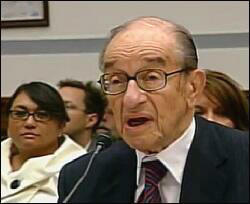Courtesy of Pam Martens.
Alan Greenspan, Former Fed Chairman, Testifying to the House Oversight Committee on How He Got It Wrong, October 23, 2008
Today marks the 15th Anniversary of the tragic events of September 11, 2001 and yet the American public remains in the dark about critical details of hundreds of billions of dollars of financial dealings by the Federal Reserve in the days, weeks and months that followed 9/11.
What has also been lost in the official 9/11 Commission Report, Congressional hearings and academic studies, is how Wall Street, on the day the planes slammed into the World Trade Towers, was on the cusp of being exposed by the New York State Attorney General, Eliot Spitzer, as the orchestrator of a fraud of unprecedented proportion against the investing public. That investigation was stalled for more than six months. It would have been politically incorrect to do perp walks outside Wall Street’s biggest investment banks as families mourned the loss of their loved ones; as U.S. savings bonds were renamed Patriot Bonds to rally patriotism around the country; and Congress paid homage to the heroes at the big banks, the stock exchanges and the Federal Reserve for getting the system back up and running in less than a week.
The loony policies of laissez-faire capitalism of Fed Chair Alan Greenspan, who worshiped at the feet of Ayn Rand, were also bailed out by the events of 9/11. Members of the Senate Banking Committee praised him on September 20, 2001 for his performance. Amazingly, at this hearing, just nine days after the attack, not one Senator asked Greenspan how much money the Fed had spent or to whom it went. The percolating collapse of Wall Street was held off for seven more years until 2008 when it finally became impossible to deny that Greenspan’s brand of financial deregulation and the repeal of the Glass-Steagall Act he had pushed for, had left Wall Street in ruins – without any assault from the skies.
Here’s where Wall Street and the U.S. economy stood on September 10, 2001, the day before an attack in lower Manhattan provided the excuse for the Federal Reserve to flood Wall Street with unquestioned amounts of cash: The Nasdaq stock market, filled with the stocks of rigged analyst research from the iconic firms on Wall Street (the target of Spitzer’s investigation), had imploded, losing 66 percent of its pumped up value and wiping out $4 trillion in wealth. While it wasn’t yet known at the time, being only officially acknowledged long after 9/11, the U.S. economy had contracted for two consecutive quarters and was looking at another negative quarter of growth.
Thus, it was quite advantageous for Alan Greenspan’s legacy as Chair of the Federal Reserve and what might have been an even worse economic slump that the Fed was given carte blanche to funnel hundreds of billions of dollars to Wall Street after 9/11 with the Federal government pumping billions more in fiscal stimulus.
…




